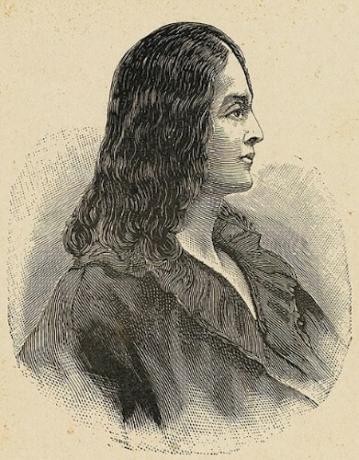Marília de Dirceu is the most famous book of Thomas Antonio Gonzaga and talks about the idealized love between Dirceu and Marília. Thus, the passionate poet declares his love for the young Maria Doroteia. But he also demonstrates his anguish at being imprisoned, a pain that finds relief only in the certainty of the affection of the woman he loves.
belonging to Thebrazilian rhadism, the work has loving idealization, pastoralism and Greco-Latin references. It is divided into three parts, having a total of 71 lyres and 14 sonnets. Moreover, it brings characteristics of both the lyrical and narrative genres, so that the character Dirceu can be both the narrator and the lyrical self of the work.
Read too: Arcadianism — the main literary movement of the 18th century
Topics of this article
- 1 - Analysis of the work Marília de Dirceu
- 2 - Thomas Antonio Gonzaga
- 3 - Historical context of Marília de Dirceu
Analysis of the work Marília de Dirceu
-
Characters of the work Marília de Dirceu
Alceste or Glauceste (Cláudio Manuel da Costa)
Alceu (Alvarenga Peixoto)
Cupid
Dirceu (Tomas Antonio Gonzaga)
Eulina
Laura
Maria (Maria Doroteia)
Venus
Work time Marília de Dirceu
The events and feelings exposed in the work Marília de Dirceu They are related at the end of the 18th century.
work space Marília de Dirceu
The book is set in Vila Rica (now Ouro Preto), in the state of Minas Gerais, and possibly on Ilha das Cobras, in Rio de Janeiro.
Do not stop now... There's more after the publicity ;)
Plot of the work Marília de Dirceu
there is not a plot proper, but fragmented facts about Dirceu and Marília. For most of the book, published in 1792, Marília is Dirceu's interlocutor, since the poet directs his words to her. The character tries to convince his beloved that he is not just any shepherd, because the others, according to him, respect “the power of [his] staff”.
He also praises the beloved and, at all times, highlights her beauty and perfection. It is thus described by him:
Your eyes spread divine light,
To whom the sunlight dares in vain;
Delicate and fine poppy or rose
It covers your faces, which are the color of snow.
Your hair is a strand of gold;
He your beautiful body vapor balm.
Oh! no, not heaven, gentle shepherdess,
For the glory of Love equal treasure.
In this way, the book mixes poetry with narrative. Dirceu compares Marília to love itself. He also reports that, when he fell in love with her, he set out to serve his beloved, led her cattle to drink at "the clearest fountain" and the meadow "of the best grass." He also talks about Marília's resistance in responding to her love.
To give an idea of his own state of love, Dirceu uses an allegory. He says that one day he found the god of “careless” love, without the arrows in his hand. Soon “anger lights up in the heart” and Dirceu killed Cupid. However, Marília felt sorry for him and, crying, washed his wounds with her tears, which ended up resurrecting Cupid, that is, love.
In this way, Dirceu concludes that while he lives “Marília is beautiful / Love does not die”. However, Dirceu is aware of the ephemeral nature of things and exhorts Marília to take advantage of “the time, before it does/ The damage of robbing the body of strength,/ And grace from the countenance”. And, using Glauceste as an interlocutor, he says that his beloved Eulina is inferior to Marília.
In the first part of the work, he also suggests that there is a certain shepherdess interested in him., which makes Marília jealous. He then reassures her by saying: “Never fear / Harm from that / That is not the same”. Once again, he attests to Marília's superiority. And again he reports an event involving Cupid.
The god of love was talking to his Geniuses, and one of them compared Dirceu's heart to a rock, because the arrows hit and broke. He stated: “Only Marília’s graces / Can overcome such a hard, / So free heart”. Cupid then brought Marília closer to Dirceu, and the shepherd fell in love. In addition to this, others episodes involving the god of love are reported.
In the second part of the work, Dirceu, despite the state he is in, obeys love and continues to talk about his feelings for Marília. She says she is in a “cruel dark dungeon”, where she remembers the “beautiful eyes” of her beloved. She claims that what brought him there was a “vile slander”.
In this situation, your blond hair becomes whiter and falls out, and your face becomes discolored and wrinkles. He recalls events lived alongside his beloved, in a bucolic environment, where he placed a sheep on his lap and told her “a thousand tender things”. But Marília realized that the words were directed at her and not at the sheep.
Thus, he alternates his harsh reality with the memory of his beloved, the only thing that keeps him from giving up:
In this sad dungeon,
Of a half-living body tomb,
Inda, Marília, I love it
Your beauty.
Unlike the first part, in which everything takes place in a pleasant and bucolic environment, on Monday part, space is a dungeon. In common, they have love being declared all the time and praise for Marília's beauty. Dirceu continues his lament and says that “impious luck” stole everything from him in a single “unhappy day” and put him in an “infamous tomb”, “dark dungeon”.
Even so, he has the company of Marília, through memory and her letters, which tell him to follow his destiny, in addition to promising him loyalty. However, in the third and last part, the farewell takes place:
I finally leave, and I leave without seeing you,
That in this fatal instant
It must be your face
Very disastrous in my eyes.
narrator of the work Marília de Dirceu
Ostoryteller of the work is the character Dirceu, but it can also be considered the I lyrical, since the story transits between the lyrical and narrative genres.
Characteristics of the work Marília de Dirceu
The work Marília de Dirceuis divided into three parts. The first consists of 33 lira. The second, for 38 lire. Finally, the third part has nine lire and 14 sonnets. This book belongs to Brazilian Arcadianism, therefore it has the following features:
◦ pastoralism;
◦ idealized love and woman;
◦ Greco-Roman references;
◦ flee urban (get out of town);
◦ mediocre aurea (golden mediocrity);
◦ locus amoenus (nice place);
◦ useless truncat (cut the useless);
◦ carpe diem (enjoy the moment).
Read too: Cláudio Manuel da Costa — another big name in Brazilian Arcadianism
Thomas Antonio Gonzaga

Thomas Antonio Gonzaga was born on August 11, 1744, in Harbor, Portuguese city. He was the son of a Brazilian and a Portuguese mother. In 1752, the author went to live in Brazil, in the company of his father, who held the position of procurator-general of Pernambuco. Here, he studied at the Jesuit College in Bahia.
He returned to Portugal in 1761 to study law at the University of Coimbra. Around 1782, became ombudsman general of Vila Rica, in Minas Gerais. In that city, he became engaged to Maria Doroteia (Marília de Dirceu). But the marriage did not take place, as the poet was accused of conspiracy, arrested and sentenced to exile in Mozambique, where he died in 1810.
historical context of Marília de Dirceu
The facts presented in Marília de Dirceu are located in 18th century context in Brazil. Therefore, they refer to the period preceding the Inconfidência Mineira, but also to the period in which Tomás Antônio Gonzaga was imprisoned, awaiting the trial that led to his banishment.
The Inconfidência Mineira was a conspiracy that took place in 1789, in the state of Minas Gerais. Intellectuals, priests and soldiers were involved, such as the ensign Tiradentes. Inspired by Enlightenment ideals, they intended to get the state of Minas to become an independent country.
By Warley Souza
Literature Teacher
Click here and discover 20 classics of Brazilian literature. Learn a little about each one of them and get to know a little about the rich national literary tradition.
Access to understand what Arcadianism was in Brazil, its main characteristics, historical context, main authors and their respective works.
Learn what Classicism was and how this movement developed in Europe. Know its characteristics and main works and authors.
Find out who the writer Cláudio Manuel da Costa was. Discover the characteristics of his main works. See the analysis of some of the author's poems.
Learn more about this cultural movement that incited the French Revolution and Inconfidência Mineira!
Meet the Brazilian writer Santa Rita Durão. Find out what are the main characteristics of his work and learn a little more about his book Caramuru.
Know who was the writer Tomás Antônio Gonzaga. See what are the main characteristics of his works and, in addition, get to know his book “Marília de Dirceu”.


